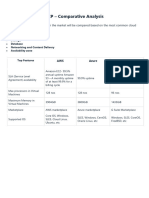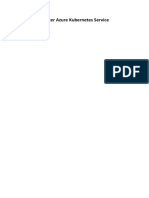Kafka's Architecture: Find Answers On The Fly, or Master Something New. Subscribe Today
Uploaded by
Dallas GuyKafka's Architecture: Find Answers On The Fly, or Master Something New. Subscribe Today
Uploaded by
Dallas GuyPREV NEXT
⏮ Kafka origins Building Data Streaming Applications with Apache Kafka Message topics ⏭
Kafka's architecture
This section introduces you to Kafka architecture. By the end of this section, you will have a clear understanding
of both the logical and physical architecture of Kafka. Let's see how Kafka components are organized logically.
Every message in Kafka topics is a collection of bytes. This collection is represented as an array. Producers are
the applications that store information in Kafka queues. They send messages to Kafka topics that can store all
types of messages. Every topic is further differentiated into partitions. Each partition stores messages in the
sequence in which they arrive. There are two major operations that producers/consumers can perform in Kafka.
Producers append to the end of the write-ahead log files. Consumers fetch messages from these log files
belonging to a given topic partition. Physically, each topic is spread over different Kafka brokers, which host one
or two partitions of each topic.
Ideally, Kafka pipelines should have a uniform number of partitions per broker and all topics on each machine.
Consumers are applications or processes that subscribe to a topic or receive messages from these topics.
The following diagram shows you the conceptual layout of a Kafka cluster:
Find answers on the fly, or master something new. Subscribe today. See pricing options.
Kafka's logical architecture
The preceding paragraphs explain the logical architecture of Kafka and how different logical components
coherently work together. While it is important to understand how Kafka architecture is divided logically, you
also need to understand what Kafka's physical architecture looks like. This will help you in later chapters as well.
A Kafka cluster is basically composed of one or more servers (nodes). The following diagram depicts how a
multi-node Kafka cluster looks:
Kafka's physical architecture
A typical Kafka cluster consists of multiple brokers. It helps in load-balancing message reads and writes to the
cluster. Each of these brokers is stateless. However, they use Zookeeper to maintain their states. Each topic
partition has one of the brokers as a leader and zero or more brokers as followers. The leaders manage any read
or write requests for their respective partitions. Followers replicate the leader in the background without actively
interfering with the leader's working. You should think of followers as a backup for the leader and one of those
followers will be chosen as the leader in the case of leader failure.
Each server in a Kafka cluster will either be a leader for some of the topic's partitions or a follower for
others. In this way, the load on every server is equally balanced. Kafka broker leader election is done
with the help of Zookeeper.
Zookeeper is an important component of a Kafka cluster. It manages and coordinates Kafka brokers and
consumers. Zookeeper keeps track of any new broker additions or any existing broker failures in the Kafka
cluster. Accordingly, it will notify the producer or consumers of Kafka queues about the cluster state. This helps
both producers and consumers in coordinating work with active brokers. Zookeeper also records which broker is
the leader for which topic partition and passes on this information to the producer or consumer to read and write
the messages.
At this juncture, you must be familiar with producer and consumer applications with respect to the Kafka cluster.
However, it is beneficial to touch on these briefly so that you can verify your understanding. Producers push data
to brokers. At the time of publishing data, producers search for the elected leader (broker) of the respective topic
partition and automatically send a message to that leader broker server. Similarly, the consumer reads messages
from brokers.
The consumer records its state with the help of Zookeeper as Kafka brokers are stateless. This design helps in
scaling Kafka well. The consumer offset value is maintained by Zookeeper. The consumer records how many
messages have been consumed by it using partition offset. It ultimately acknowledges that message offset to
Zookeeper. It means that the consumer has consumed all prior messages.
This brings us to an end of our section on Kafka architecture. Hopefully, by this time, you are well
versed with Kafka architecture and understand all logical and physical components. The next sections
cover each of these components in detail. However, it is imperative that you understand the overall
Kafka architecture before delving into each of the components.
Support / Sign Out
© 2021 O'Reilly Media, Inc. Terms of Service / Privacy Policy
You might also like
- Artifactory With Amazon Ecs On The Aws Cloud PDFNo ratings yetArtifactory With Amazon Ecs On The Aws Cloud PDF37 pages
- Kafka Producer Internals: Find Answers On The Fly, or Master Something New. Subscribe TodayNo ratings yetKafka Producer Internals: Find Answers On The Fly, or Master Something New. Subscribe Today1 page
- High Availability and Disaster Recovery KubernetesNo ratings yetHigh Availability and Disaster Recovery Kubernetes6 pages
- CIS Amazon Web Services Three-Tier Web Architecture Benchmark v1.0.0No ratings yetCIS Amazon Web Services Three-Tier Web Architecture Benchmark v1.0.0215 pages
- Exercise - Deploy An Application On Your Azure Kubernetes Service Cluster - Training - Microsoft LearnNo ratings yetExercise - Deploy An Application On Your Azure Kubernetes Service Cluster - Training - Microsoft Learn7 pages
- Kubernetes Networking Explained - IntroductionNo ratings yetKubernetes Networking Explained - Introduction13 pages
- Locking Down Your Kubernetes Cluster With LinkerdNo ratings yetLocking Down Your Kubernetes Cluster With Linkerd24 pages
- Azure Devops: Sato Naoki (Neo) - @satonaoki Jazug Tohoku Azure Devops #Jazug #AzuredevopsNo ratings yetAzure Devops: Sato Naoki (Neo) - @satonaoki Jazug Tohoku Azure Devops #Jazug #Azuredevops34 pages
- Concept of Cluster: Prepared By: Vinutha CNo ratings yetConcept of Cluster: Prepared By: Vinutha C9 pages
- Configure Tomcat 6 For SSL Using Java KeytoolNo ratings yetConfigure Tomcat 6 For SSL Using Java Keytool4 pages
- TheNewStack Book101 KubernetesSolutionsDirectory100% (1)TheNewStack Book101 KubernetesSolutionsDirectory22 pages
- Ibm Webshere Application Server Vertical ClusteringNo ratings yetIbm Webshere Application Server Vertical Clustering34 pages
- Sudhir Gannavarapu Full Stack Developer Professional SummaryNo ratings yetSudhir Gannavarapu Full Stack Developer Professional Summary4 pages
- Automating Stateful Applications With Kubernetes Operators Josh Wood Ryan Jarvinen Red HatNo ratings yetAutomating Stateful Applications With Kubernetes Operators Josh Wood Ryan Jarvinen Red Hat28 pages
- Running Spring Boot Microservices On KubernetesNo ratings yetRunning Spring Boot Microservices On Kubernetes5 pages
- Azure Kubernetes Service - Architecture & Implementation Case StudyNo ratings yetAzure Kubernetes Service - Architecture & Implementation Case Study9 pages
- Migrate To AWS Using CloudEndure and AWS Migration Hub ENT313-R2No ratings yetMigrate To AWS Using CloudEndure and AWS Migration Hub ENT313-R218 pages
- Securing Service Bus REST Services Using OAuth2No ratings yetSecuring Service Bus REST Services Using OAuth235 pages
- Maven Tutorial: Understanding The Problem Without MavenNo ratings yetMaven Tutorial: Understanding The Problem Without Maven29 pages
- Message Partitions: Find Answers On The Fly, or Master Something New. Subscribe TodayNo ratings yetMessage Partitions: Find Answers On The Fly, or Master Something New. Subscribe Today1 page
- Kafka Producer Apis: Find Answers On The Fly, or Master Something New. Subscribe TodayNo ratings yetKafka Producer Apis: Find Answers On The Fly, or Master Something New. Subscribe Today1 page
- Custom Partition - Building Data Streaming Applications With Apache KafkaNo ratings yetCustom Partition - Building Data Streaming Applications With Apache Kafka1 page
- Best Practices: Find Answers On The Fly, or Master Something New. Subscribe TodayNo ratings yetBest Practices: Find Answers On The Fly, or Master Something New. Subscribe Today1 page
- Conventions - Building Data Streaming Applications With Apache KafkaNo ratings yetConventions - Building Data Streaming Applications With Apache Kafka1 page
- Advance Queuing Messaging Protocol - Building Data Streaming Applications With Apache KafkaNo ratings yetAdvance Queuing Messaging Protocol - Building Data Streaming Applications With Apache Kafka1 page
- Additional Producer Configuration: Find Answers On The Fly, or Master Something New. Subscribe TodayNo ratings yetAdditional Producer Configuration: Find Answers On The Fly, or Master Something New. Subscribe Today1 page
- (Ebook) Mastering VMware Horizon 8: An Advanced Guide to Delivering Virtual Desktops and Virtual Apps by Peter von Oven ISBN 9781484272602, 1484272609 - Download the ebook now for full and detailed access100% (2)(Ebook) Mastering VMware Horizon 8: An Advanced Guide to Delivering Virtual Desktops and Virtual Apps by Peter von Oven ISBN 9781484272602, 1484272609 - Download the ebook now for full and detailed access84 pages
- Experion HS Configurator Reference Guide R430No ratings yetExperion HS Configurator Reference Guide R43010 pages
- Use Excel VBA To Open A Text File and Search It For A Specific StringNo ratings yetUse Excel VBA To Open A Text File and Search It For A Specific String3 pages
- Submitting Your MATLAB Jobs Using Slurm To High-Performance Clusters - by Rahul Bhadani - Towards DaNo ratings yetSubmitting Your MATLAB Jobs Using Slurm To High-Performance Clusters - by Rahul Bhadani - Towards Da1 page
- TCS (TATA Consultancy Services) Placement PapersNo ratings yetTCS (TATA Consultancy Services) Placement Papers11 pages
- AMD ZEN4' EPYC 4004 Processor Update: AltosNo ratings yetAMD ZEN4' EPYC 4004 Processor Update: Altos11 pages
- Torrent: Pass The Actual Test With The Latest Vce Torrent at First AttemptNo ratings yetTorrent: Pass The Actual Test With The Latest Vce Torrent at First Attempt8 pages
- Installing Operating the Osa 54xx Family Sync DirectorNo ratings yetInstalling Operating the Osa 54xx Family Sync Director2 pages
- Avocent Acs 6000 Command Reference Guide PDFNo ratings yetAvocent Acs 6000 Command Reference Guide PDF60 pages
































































































